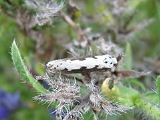
Ethmia bipunctella
Encyclopedia
Ethmia bipunctella is a diurnal moth
from the family Ethmiidae
. It can be found in Central
and Southern Europe
, North Africa
, Asia
and the northeastern part of North America
. E. iranella was formerly included here as a subspecies
.
.jpg) The wingspan of the moth ranges from 19–28 mm (0.748031496062992–1.1 ). The flight time ranges from May to September. The moth is bivoltine
The wingspan of the moth ranges from 19–28 mm (0.748031496062992–1.1 ). The flight time ranges from May to September. The moth is bivoltine
, having two generations per year.
The most important host plant is the Viper's Bugloss, but also Anchusa officinalis
and plants from the genus Symphytum
. Pupa
e are attached to dead wood.
Moth
A moth is an insect closely related to the butterfly, both being of the order Lepidoptera. Moths form the majority of this order; there are thought to be 150,000 to 250,000 different species of moth , with thousands of species yet to be described...
from the family Ethmiidae
Ethmiidae
Ethmiidae is a family of small moths in the superfamily Gelechioidea. It is sometimes included in the Elachistidae or the Oecophoridae as a subfamily Ethmiinae.-Genera:...
. It can be found in Central
Central Europe
Central Europe or alternatively Middle Europe is a region of the European continent lying between the variously defined areas of Eastern and Western Europe...
and Southern Europe
Southern Europe
The term Southern Europe, at its most general definition, is used to mean "all countries in the south of Europe". However, the concept, at different times, has had different meanings, providing additional political, linguistic and cultural context to the definition in addition to the typical...
, North Africa
North Africa
North Africa or Northern Africa is the northernmost region of the African continent, linked by the Sahara to Sub-Saharan Africa. Geopolitically, the United Nations definition of Northern Africa includes eight countries or territories; Algeria, Egypt, Libya, Morocco, South Sudan, Sudan, Tunisia, and...
, Asia
Asia
Asia is the world's largest and most populous continent, located primarily in the eastern and northern hemispheres. It covers 8.7% of the Earth's total surface area and with approximately 3.879 billion people, it hosts 60% of the world's current human population...
and the northeastern part of North America
North America
North America is a continent wholly within the Northern Hemisphere and almost wholly within the Western Hemisphere. It is also considered a northern subcontinent of the Americas...
. E. iranella was formerly included here as a subspecies
Subspecies
Subspecies in biological classification, is either a taxonomic rank subordinate to species, ora taxonomic unit in that rank . A subspecies cannot be recognized in isolation: a species will either be recognized as having no subspecies at all or two or more, never just one...
.
.jpg)
Voltinism
Voltinism is a term used in biology to indicate the number of broods or generations of an organism in a year. The term is particularly in use in sericulture, where silkworm varieties vary in their voltinism....
, having two generations per year.
The most important host plant is the Viper's Bugloss, but also Anchusa officinalis
Anchusa officinalis
Anchusa officinalis or Common Bugloss or Alkanet is a plant species of the genus Anchusa....
and plants from the genus Symphytum
Comfrey
Comfrey is an important herb in organic gardening. It is used as a fertilizer and also has many purported medicinal uses...
. Pupa
Pupa
A pupa is the life stage of some insects undergoing transformation. The pupal stage is found only in holometabolous insects, those that undergo a complete metamorphosis, going through four life stages; embryo, larva, pupa and imago...
e are attached to dead wood.

